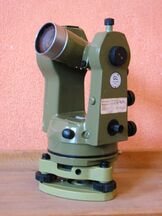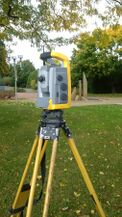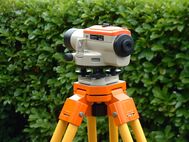Engineering:Geomatics engineering

Geomatics engineering is a rapidly developing engineering discipline which focuses on spatial information (i.e. information that has a location).[1] The location is the primary factor used to integrate a very wide range of data for spatial analysis and visualization. Geomatics engineers design, develop, and operate systems for collecting and analyzing spatial information about the land, the oceans, natural resources, and manmade features.[2][3]
Geomatics engineers apply engineering principles to spatial information and implement relational data structures involving measurement sciences, thus using geomatics and acting as spatial information engineers. Geomatics engineers manage local, regional, national and global spatial data infrastructures.[4] Geomatics engineering also involves aspects of Computer Engineering, Software Engineering and Civil Engineering.[5]
History
The history of surveying dates back to ancient times. The greek provided first account of surveying techniques. Euclid founded theoretical background for surveying by development of geometry. The Egyptian land register which dates back to 3000 BC suggest the history of surveying to be too old. In ancient Egypt when Nile river flood overflowed the banks and washed out farm boundaries, survey techniques were used for re-establishment. William Roy started the principle of triangulation in Britain in 1780s. Currently used GPS satellite was first launched by US Air Force in 1978.[6][7]
Currently, the survey is done by two different approaches. The first one plane surveying which assumes the earth to be flat while geodetic survey assumes the earth to have curved surface.[8]
The more traditional land surveying strand of geomatics engineering is concerned with the determination and recording of boundaries and areas of real property parcels, and the preparation and interpretation of legal land descriptions. The tasks more closely related to civil engineering include the design and layout of public infrastructure and urban subdivisions, and mapping and control surveys for construction projects.[9]
Significance
Geomatics is a field that incorporates several others such as the older field of land surveying engineering along with many other aspects of spatial data management ranging from data science and cartography. Following the advanced developments in digital data processing, the nature of the tasks required of the professional land surveyor has evolved significantly in recent years, and for more and more people the term "surveying" no longer accurately covers the whole range of tasks that the profession deals with.[4] As our societies become more complex, information with a spatial position associated with it becomes more critical to decision-making, both from a personal and a business perspective, and also from a community and a large-scale governmental viewpoint.[10]
Geomatics engineers serve society by collecting, monitoring, archiving, and maintaining diverse spatial data infrastructures. Geomatics engineers utilize a wide range of technologically advanced tools such as digital theodolite/distance meter total stations, Global Positioning System (GPS) equipment, digital aerial imagery (both satellite and air-borne), and computer-based geographic information systems (GIS). These tools enable the geomatics engineer to gather, process, analyze, visualize and manage spatially related information to solve a wide range of technical and societal problems.
In different schools and in different countries the same education curriculum is administered with the name surveying in some, and in others with the names geomatics, civil engineering surveying, geomatics engineering, geospatial (information) engineering, surveying engineering, or geodesy and geoinformatics.[4] While these occupations were at one time often taught in civil engineering education programs, more and more universities include the departments relevant for geo-data sciences under informatics, computer science or applied mathematics.[11] These facts demonstrate the breadth, depth and scope of the highly interdisciplinary nature of geomatics engineering.[12]
Education
Geomatics engineers typically possess an academic degree in geomatics engineering. The length of study is three to five years, and the completed degree is designated as a bachelor of technology or a bachelor of engineering. The curriculum generally includes classes in physics, mathematics, project engineering, cadastre, surveying, geodesy, GIS, GPS and optionally some topics related to civil engineering. After taking basic courses in most sub-disciplines of geomatics engineering, they move on to specialize in one or more sub-disciplines at advanced levels. While an undergraduate degree (B.E) normally provides successful students with industry-accredited qualification, some academic institutions offer post-graduate degrees (MEng/MSc), which allow students to further specialize in their particular area of interest.[13][14]
Sub-disciplines
Survey engineering
Survey engineering is the core sub discipline of geomatics engineering. It looks after determination of relative position of points on above or below the land surface by means or linear and angular measurement. The positioning can 2D or 3D depending on need and availability of instruments.[15]
Geospatial engineering
[16] It involves the use of various technologiech as GPS, GIS, RS and CAD to capture, store, manipulate, anayze and visualize geographic informations.[17][18]
It plays a crucial role in enabling better planning, resource allocation and problem-solving based on spatial information.
Land Administration
Land being the basis for meeting the sustainable development agenda 2030, land administration appears to be one of the most important discipline of geomatics engineering for which an effective land administration is required. Hence it is a sub discipline that integrates various land issues from different disciplines including legal, social, economic, technical, planning and management.
See also
References
- ↑ Hazelton, N W J (September 2005). "Surveying, Geomatics, and Engineering: A 'Structure' for a Rapidly Evolving Profession". Surveying and Land Information Science 65 (3): 211–222. ProQuest 202972772.
- ↑ "Department of Geomatics Engineering | Kathmandu University". http://geom.ku.edu.np/.
- ↑ Lam, Steve Yau-Wah; Yip, Tsz Leung (February 2008). "The role of geomatics engineering in establishing the marine information system for maritime management". Maritime Policy & Management 35 (1): 53–60. doi:10.1080/03088830701848896.
- ↑ 4.0 4.1 4.2 Ghosh, Jayanta Kumar; da Silva, Irineu, eds (2020). Applications of Geomatics in Civil Engineering. Lecture Notes in Civil Engineering. 33. doi:10.1007/978-981-13-7067-0. ISBN 978-981-13-7066-3.[page needed]
- ↑ "Marshall, Wesley" (in en). https://engineering.ucdenver.edu/civil-engineering/research-specialty-areas/geomatics-gis.
- ↑ "Evolution of surveying and surveying technology | Intergovernmental Committee on Surveying and Mapping". https://www.icsm.gov.au/education/fundamentals-land-ownership-land-boundaries-and-surveying/surveyors-and-surveying-0#:~:text=The%20history%20of%20surveying%20dates,recorded%20about%20the%20same%20time..
- ↑ Engineering Surveying. Er. Dhakal, Bharat Bahadur and Er. Karki, Bhesh Kumar. ISBN 9789937703000.
- ↑ "Difference between plane and geodetic surveying". 2020-07-14. https://www.civilengineeringrealities.com/2020/07/difference-between-plane-and-geodetic-.html.
- ↑ "Surveying and geospatial sciences" (in en). https://www.rmit.edu.au/study-with-us/science/surveying-and-geospatial-sciences.
- ↑ "Bachelor in Geomatics Engineering program, BE Geomatics, TU, Tribhuvan University, | Colleges Nepal". https://www.collegesnepal.com/tribhuvan-university/be-in-geomatics-engineering/.
- ↑ "Geomatics Engineering". https://edusanjal.com/discipline/geomatics/.
- ↑ Albattah, Mahmoud M.S.; Youssef, Salah Edin (February 2021). "The potential of space geomatics engineering applications in transportation analysis and planning". The Egyptian Journal of Remote Sensing and Space Science 24 (1): 29–40. doi:10.1016/j.ejrs.2019.10.001. Bibcode: 2021EJRSS..24...29A.
- ↑ "Department of Geomatics Engineering | ME/MS in Geoinformatics". http://geom.ku.edu.np/program/me-ms-in-geoinformatics.
- ↑ "MSc in Geospatial Engineering - Tribhuvan University". https://edusanjal.com/course/msc-in-geospatial-engineering-tu/.
- ↑ https://cdnsciencepub.com/doi/abs/10.5623/geomat-2000-0021
- ↑ colorlib. "Department of Geomatics Engineering | Admission - Graduate". http://geom.ku.edu.np/graduate.
- ↑ Albattah, Mahmoud M. S.; Youssef, Salah Edin (2021-02-01). "The potential of space geomatics engineering applications in transportation analysis and planning". The Egyptian Journal of Remote Sensing and Space Science 24 (1): 29–40. doi:10.1016/j.ejrs.2019.10.001. ISSN 1110-9823. https://www.sciencedirect.com/science/article/pii/S1110982319301899.
- ↑ https://avesis.yildiz.edu.tr/yayin/96c0a47c-c3c2-42f8-8889-08291ff12b77/cartography-and-gis-education-in-geomatic-engineering/document.pdf
 |






